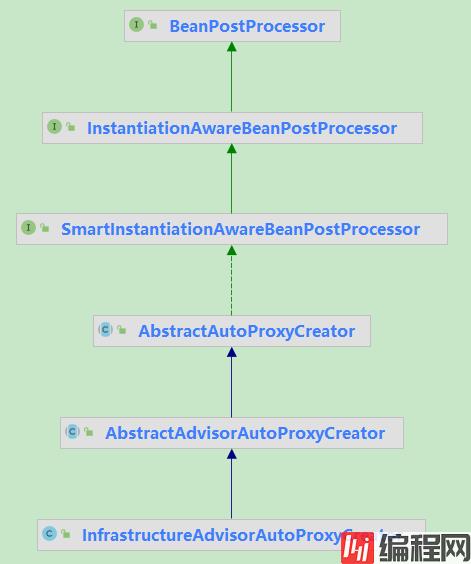Python 官方文档:入门教程 => 点击学习
目录简介问题复现原因分析解决方案方案1:懒加载方案2:不让@Async的类有循环依赖方案3:allowRawInjectionDespiteWrapping设置为true为什么@Tr
说明
本文介绍SpringBoot中的@Async导致循环依赖失败的原因及其解决方案。
概述
我们知道,spring解决了循环依赖问题,但Spring的异步(@Async)会使得循环依赖失败。本文将用实例来介绍其原因和解决方案。
启动类
启动类添加@EnableAsync以启用异步功能。
package com.knife;
import org.springframework.boot.SpringApplication;
import org.springframework.boot.autoconfigure.SpringBootApplication;
import org.springframework.scheduling.annotation.EnableAsync;
@EnableAsync
@SpringBootApplication
public class DemoApplication {
public static void main(String[] args) {
SpringApplication.run(DemoApplication.class, args);
}
}
Service
A
package com.knife.service;
import org.springframework.beans.factory.annotation.Autowired;
import org.springframework.scheduling.annotation.Async;
import org.springframework.stereotype.Component;
@Component
public class A {
@Autowired
private B b;
@Async
public void print() {
System.out.println("Hello World");
}
}
B
package com.knife.service;
import org.springframework.beans.factory.annotation.Autowired;
import org.springframework.stereotype.Component;
@Component
public class B {
@Autowired
private A a;
}
Controller
package com.knife.controller;
import com.knife.service.A;
import org.springframework.beans.factory.annotation.Autowired;
import org.springframework.WEB.bind.annotation.GetMapping;
import org.springframework.web.bind.annotation.RestController;
@RestController
public class HelloController {
@Autowired
private A a;
@GetMapping("/test")
public String test() {
a.print();
return "test success";
}
}
启动:(报错)
Caused by: org.springframework.beans.factory.BeanCurrentlyInCreationException: Error creating bean with name 'a': Bean with name 'a' has been injected into other beans [b] in its raw version as part of a circular reference, but has eventually been wrapped. This means that said other beans do not use the final version of the bean. This is often the result of over-eager type matching - consider using 'getBeanNamesForType' with the 'allowEagerInit' flag turned off, for example.
at org.springframework.beans.factory.support.AbstractAutowireCapableBeanFactory.doCreateBean(AbstractAutowireCapableBeanFactory.java:624) ~[spring-beans-5.2.6.RELEASE.jar:5.2.6.RELEASE]
at org.springframework.beans.factory.support.AbstractAutowireCapableBeanFactory.createBean(AbstractAutowireCapableBeanFactory.java:517) ~[spring-beans-5.2.6.RELEASE.jar:5.2.6.RELEASE]
at org.springframework.beans.factory.support.AbstractBeanFactory.lambda$doGetBean$0(AbstractBeanFactory.java:323) ~[spring-beans-5.2.6.RELEASE.jar:5.2.6.RELEASE]
at org.springframework.beans.factory.support.DefaultSingletonBeanReGIStry.getSingleton(DefaultSingletonBeanRegistry.java:226) ~[spring-beans-5.2.6.RELEASE.jar:5.2.6.RELEASE]
at org.springframework.beans.factory.support.AbstractBeanFactory.doGetBean(AbstractBeanFactory.java:321) ~[spring-beans-5.2.6.RELEASE.jar:5.2.6.RELEASE]
at org.springframework.beans.factory.support.AbstractBeanFactory.getBean(AbstractBeanFactory.java:202) ~[spring-beans-5.2.6.RELEASE.jar:5.2.6.RELEASE]
at org.springframework.beans.factory.config.DependencyDescriptor.resolveCandidate(DependencyDescriptor.java:276) ~[spring-beans-5.2.6.RELEASE.jar:5.2.6.RELEASE]
at org.springframework.beans.factory.support.DefaultListableBeanFactory.doResolveDependency(DefaultListableBeanFactory.java:1306) ~[spring-beans-5.2.6.RELEASE.jar:5.2.6.RELEASE]
at org.springframework.beans.factory.support.DefaultListableBeanFactory.resolveDependency(DefaultListableBeanFactory.java:1226) ~[spring-beans-5.2.6.RELEASE.jar:5.2.6.RELEASE]
at org.springframework.beans.factory.annotation.AutowiredAnnotationBeanPostProcessor$AutowiredFieldElement.inject(AutowiredAnnotationBeanPostProcessor.java:640) ~[spring-beans-5.2.6.RELEASE.jar:5.2.6.RELEASE]
... 20 common frames omitted
@EnableAsync开启时向容器内注入AsyncAnnotationBeanPostProcessor,它是一个BeanPostProcessor,实现了postProcessAfterInitialization方法。创建代理的动作在抽象父类AbstractAdvisingBeanPostProcessor上:
// 这个方法主要是为有@Async 注解的 bean 生成代理对象
@Override
public Object postProcessAfterInitialization(Object bean, String beanName) {
if (this.advisor == null || bean instanceof aopInfrastructureBean) {
// Ignore AOP infrastructure such as scoped proxies.
return bean;
}
// 如果此Bean已经被代理了(比如已经被事务那边给代理了~~)
if (bean instanceof Advised) {
Advised advised = (Advised) bean;
if (!advised.isFrozen() && isEligible(AopUtils.getTargetClass(bean))) {
// Add our local Advisor to the existing proxy's Advisor chain...
// beforeExistingAdvisors决定这该advisor最先执行还是最后执行
// 此处的advisor为:AsyncAnnotationAdvisor 它切入Class和Method标注有@Aysnc注解的地方~~~
if (this.beforeExistingAdvisors) {
advised.addAdvisor(0, this.advisor);
} else {
advised.addAdvisor(this.advisor);
}
return bean;
}
}
// 若不是代理对象,则进行处理
if (isEligible(bean, beanName)) {
//copy属性 proxyFactory.copyFrom(this); 工厂模式生成一个新的 ProxyFactory
ProxyFactory proxyFactory = prepareProxyFactory(bean, beanName);
// 如果没有采用CGLIB,就去探测它的接口
if (!proxyFactory.isProxyTargetClass()) {
evaluateProxyInterfaces(bean.getClass(), proxyFactory);
}
// 切入切面并创建一个getProxy 代理对象
proxyFactory.addAdvisor(this.advisor);
customizeProxyFactory(proxyFactory);
return proxyFactory.getProxy(getProxyClassLoader());
}
// No proxy needed.
return bean;
}
protected boolean isEligible(Object bean, String beanName) {
return isEligible(bean.getClass());
}
protected boolean isEligible(Class<?> targetClass) {
//首次从 eligibleBeans 这个 map 中获取值肯定为 null
Boolean eligible = this.eligibleBeans.get(targetClass);
if (eligible != null) {
return eligible;
}
//如果没有配置 advisor(即:切面),返回 false
if (this.advisor == null) {
return false;
}
// 若类或方法有 @Aysnc 注解,AopUtils.canApply 会判断为 true
eligible = AopUtils.canApply(this.advisor, targetClass);
this.eligibleBeans.put(targetClass, eligible);
return eligible;
}
有三种方案:
懒加载:使用@Lazy或者@ComponentScan(lazyInit = true)
不要让@Async的Bean参与循环依赖
将allowRawInjectionDespiteWrapping设置为true
说明
建议使用@Lazy。
不建议使用@ComponentScan(lazyInit = true),因为它是全局的,容易产生误伤。
实例
这两个方法都是可以的:
法1:将@Lazy放到A类的b成员上边
package com.knife.service;
import org.springframework.beans.factory.annotation.Autowired;
import org.springframework.context.annotation.Lazy;
import org.springframework.scheduling.annotation.Async;
import org.springframework.stereotype.Component;
@Component
public class A {
@Lazy
@Autowired
private B b;
@Async
public void print() {
System.out.println("Hello World");
}
}
法2:将@Lazy放到B类的a成员上边
package com.knife.service;
import org.springframework.beans.factory.annotation.Autowired;
import org.springframework.context.annotation.Lazy;
import org.springframework.stereotype.Component;
@Component
public class B {
@Lazy
@Autowired
private A a;
}
这样启动就能成功。
原理分析
以这种写法为例进行分析:@Lazy放到A类的b成员上边。
即:
package com.knife.service;
import org.springframework.beans.factory.annotation.Autowired;
import org.springframework.context.annotation.Lazy;
import org.springframework.scheduling.annotation.Async;
import org.springframework.stereotype.Component;
@Component
public class A {
@Lazy
@Autowired
private B b;
@Async
public void print() {
System.out.println("Hello World");
}
}
假设 A 先加载,在创建 A 的实例时,会触发依赖属性 B 的加载,在加载 B 时发现它是一个被 @Lazy 标记过的属性。那么就不会去直接加载 B,而是产生一个代理对象注入到了 A 中,这样 A 就能正常的初始化完成放入一级缓存了。
B 加载时,将前边生成的B代理对象取出,再注入 A 就能直接从一级缓存中获取到 A,这样 B 也能正常初始化完成了。所以,循环依赖的问题就解决了。
略。
说明
本方法不建议使用。
这样配置后,容器启动不报错了。但是:Bean A的@Aysnc方法不起作用了。因为Bean B里面依赖的a是个原始对象,所以它不能执行异步操作(即使容器内的a是个代理对象)。
方法
import org.springframework.beans.BeansException;
import org.springframework.beans.factory.config.BeanFactoryPostProcessor;
import org.springframework.beans.factory.config.ConfigurableListableBeanFactory;
import org.springframework.beans.factory.support.AbstractAutowireCapableBeanFactory;
import org.springframework.stereotype.Component;
@Component
public class MyBeanFactoryPostProcessor implements BeanFactoryPostProcessor {
@Override
public void postProcessBeanFactory(ConfigurableListableBeanFactory beanFactory) throws BeansException {
((AbstractAutowireCapableBeanFactory) beanFactory).setAllowRawInjectionDespiteWrapping(true);
}
}
概述
同为创建动态代理对象,同为一个注解标注在类/方法上,为何@Transactional就不会出现这种启动报错呢?
原因是,它们代理的创建的方式不同:
@Transactional创建代理的方式:使用自动代理创建器InfrastructureAdvisorAutoProxyCreator(AbstractAutoProxyCreator的子类),它实现了getEarlyBeanReference()方法从而很好的对循环依赖提供了支持
@Async创建代理的方式:使用AsyncAnnotationBeanPostProcessor单独的后置处理器。它只在一处postProcessAfterInitialization()实现了对代理对象的创建,因此若它被循环依赖了,就会报错
详解

处理@Transactional注解的是InfrastructureAdvisorAutoProxyCreator,它是SmartInstantiationAwareBeanPostProcessor的子类。AbstractAutoProxyCreator对SmartInstantiationAwareBeanPostProcessor的getEarlyBeanReference方法进行了覆写:
AbstractAutoProxyCreator# getEarlyBeanReference
public abstract class AbstractAutoProxyCreator extends ProxyProcessorSupport
implements SmartInstantiationAwareBeanPostProcessor, BeanFactoryAware {
// 其他代码
@Override
public Object getEarlyBeanReference(Object bean, String beanName) {
Object cacheKey = getCacheKey(bean.getClass(), beanName);
this.earlyProxyReferences.put(cacheKey, bean);
return wrapifNecessary(bean, beanName, cacheKey);
}
}
AbstractAutoProxyCreator#postProcessAfterInitialization方法中,判断是否代理过,是的话,直接返回:
public abstract class AbstractAutoProxyCreator extends ProxyProcessorSupport
implements SmartInstantiationAwareBeanPostProcessor, BeanFactoryAware {
// 其他代码
@Override
public Object postProcessAfterInitialization(@Nullable Object bean, String beanName) {
if (bean != null) {
Object cacheKey = getCacheKey(bean.getClass(), beanName);
if (this.earlyProxyReferences.remove(cacheKey) != bean) {
return wrapIfNecessary(bean, beanName, cacheKey);
}
}
return bean;
}
}以上就是Spring处理@Async导致的循环依赖失败问题的方案详解的详细内容,更多关于Spring 循环依赖失败的资料请关注编程网其它相关文章!
--结束END--
本文标题: Spring处理@Async导致的循环依赖失败问题的方案详解
本文链接: https://www.lsjlt.com/news/153963.html(转载时请注明来源链接)
有问题或投稿请发送至: 邮箱/279061341@qq.com QQ/279061341
下载Word文档到电脑,方便收藏和打印~
2024-03-01
2024-03-01
2024-03-01
2024-02-29
2024-02-29
2024-02-29
2024-02-29
2024-02-29
2024-02-29
2024-02-29
回答
回答
回答
回答
回答
回答
回答
回答
回答
回答
0